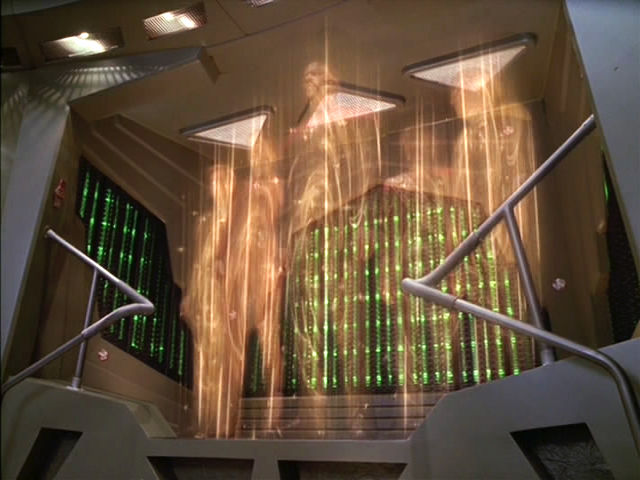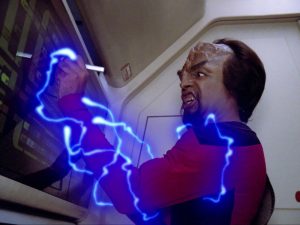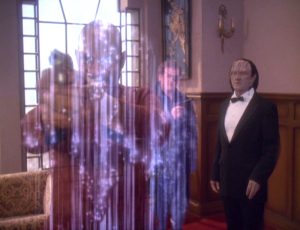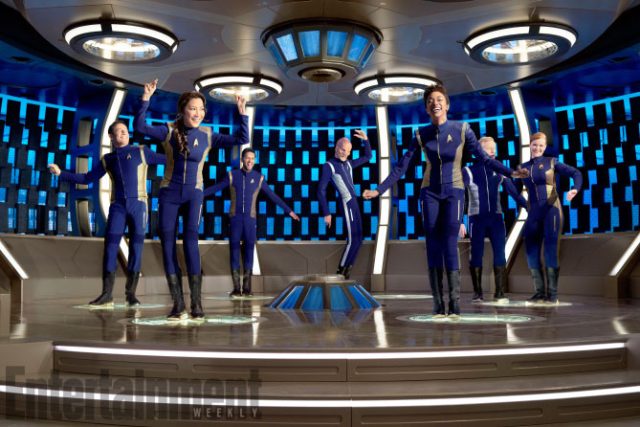
Beaming without thinking?
In The Next Generation’s first season, we find another clue. In the episode “Lonely Among Us," an energy being merges with Picard’s consciousness, then uses the transporter to beam, with Picard’s body, back into its native nebula as pure energy without rematerializing. And this scheme works. Both the entity’s consciousness and Picard’s are able to exist in the nebula without being reconstituted as a physical body.
That by itself is weird. We don’t know how “beings of pure energy” work (and according to our discussion with an astrophysicist, they probably wouldn’t), but Picard at least shouldn’t be able to have any sort of thought or experience without a brain. At least, he shouldn't be able to unless the transporter’s somehow built to maintain some sort of continuous neural activity while going throughout transport. That would explain Barclay’s ability to see microbes while inside the matter stream. It also matches up nicely with Okuda’s “dimensional transfer thing” sentiment.
There’s another oddity in that "Lonely Among Us" episode. In order to save Picard, the crew allows his consciousness to return to the ship, traveling through its computer systems. Ultimately, they’re able to use the transporter to materialize a new version of Picard. But this new version is created from the computer’s stored pattern of Picard, which was stored as he’d just beamed out.

At first this sounds like the transporter can be used to simply copy a person, and the copy is totally separate from the original. But we're missing one important detail: the episode portrays the situation such that this is an unusual circumstance. The only reason the crew can create a viable copy is because they merge their physical copy with Picard’s consciousness, which was roaming the ship as an energy being. Before they knew his consciousness was roaming the ship as energy, no one thought to bring Picard back using the stored transporter pattern alone.
This implies that, for some reason, Trek requires an ongoing process of mental activity during the transporter beam. Without it, we’re told, the crew wouldn’t be able to bring Picard back.

Then, there’s that aforementioned Deep Space Nine episode, “Our Man Bashir." Again, this episode treats the transporter process as if the mental processes are somehow handled separately by the machine. As the crew is about to lose the rapidly degrading transporter signals of Sisko and the others, Odo declares, “We're going to have to preserve the neural signatures of everyone on that runabout.” Ultimately, they do this by transferring the minds of their crewmates into the station’s computer, erasing their entire database to do so. The physical patterns, meanwhile, are separately sent into Bashir’s holosuite program, divorced from their personalities and memories.
There’s no reason for this to be the case under the conventional model of the transporter. “Neural signals,” or rather the activity of your brain, is composed of exchanges of ions, which are usually atoms missing one or more electrons. These are physical particles that would be converted to energy just like everything else, the same goes for the chemicals and cells in your brain. There should be no difference between the brain and the rest of the body; they shouldn’t be treated separately.
But if the people of the 24th century care about the continuity of their existence, they would have likely figured out a way to continue the process of brain activity even if the rest of the body is constructed anew at the destination.
All this means Trek crews would have had to send the brain a different way. The trouble is, that sounds a bit like asking too much. How can mental activity be sent, active, in a transporter beam without violating the laws of physics?
-
Voyager's transporter.
-
Christopher L. Bennett poses in front of the model Enterprise.
Quantum resolution
Christopher L. Bennett, a Star Trek novelist who always puts a lot of thought into the science and philosophy behind his stories, grappled with this very issue in a blog post. “I’m not stepping in one of those things—or having one of my beloved characters step into one, at any rate—unless I can be persuaded that there’s a continuity of self-awareness from one end to the other,” he wrote.
Bennett concludes that quantum teleportation—a real phenomenon—offers a conclusive, scientific answer to the problem. Quantum teleportation is a process by which information about a particle’s quantum state is traded with another particle at the receiving end, essentially transforming that particle into the original particle.
Crucial to this process is quantum entanglement, a process in which two particles that interact can become correlated with each other. Particles in a human body (or any macroscopic object) are becoming entangled all the time, since they’re interacting all the time. Bennett argues that it’s this constant entanglement that allows a human brain to be a continuous whole in the first place. In other words, saying there’s a continuity of your brain’s structure simply means that its particles are correlated with each other via quantum entanglement, according to Bennett.
“As I see it, since quantum identity is defined by state information rather than physical substance, the 'self' endures in the transporter pattern—the energy matrix encoding the quantum-level information of the transported subject's structure—while the physical particles of the body are dissociated (i.e. have their state information temporarily removed from them and stored in the beam instead),” Bennett told Ars. “So when characters in Trek talk about the transporter converting matter to energy, my rationalization is that they don't literally mean mass-energy conversion by E=mc2 (which would entail a horrifyingly destructive energy release), but rather they are talking about your identity, your physical pattern and consciousness, being temporarily encoded in the beam's energy matrix (the transporter pattern) until they can be reunited with your particle stream.”
We won’t get too deep into the quantum mechanical detail here, though you should check out the blog post for more. For our purposes, the important point is that this allows for the continuity we’re looking for. The person who materializes on the planet is the person who stepped onto the pad.
This idea neatly dovetails with the evidence we've seen in the show. If the transporter is separating your particles from their state information and sending the state information as part of an energy beam along with the particles themselves, this could explain why Picard's "energy" was needed to recombine with his physical pattern in "Lonely Among Us." It can also explain why Barclay could remain conscious during transport in "Realm of Fear"—a person exists throughout transport, but they're just temporarily not connected to the atoms that make them up.
The problem with such a heady rationale, of course, is setting up a scenario where this could actually work, even in a Star Trek setting. Is anything like this possible?

“Alas no,” said Lawrence Krauss, a physicist at Arizona State University. Kraus is the director of “The Origins Project” there and author of The Physics of Star Trek. He did not mince words: “Humans [are] not in [a] carefully prepared quantum state so can't entangle.”
One might imagine that’s a simple limit of present-day technology that our Star Trek-y descendants might one day overcome, but Krauss didn’t see it that way. Anything that you could get into such a carefully prepared state, “I think that would not be a human,” Krauss said. “It would resemble a human like an atom resembles a human.”
That’s certainly a hitch in the plan, but it's no surprise to Krauss. In The Physics of Star Trek, he examines the plausibility of each of the major Trek technologies, and his section on the transporter deems it as easily the least plausible in the entire book. Even warp drive, itself highly far-fetched, isn’t ruled out as thoroughly as the transporter.
Krauss doesn’t get into quantum teleportation in the book, instead discussing the more conventional idea of taking people apart atom by atom and sending them that way. Nonetheless, his writing illustrates everything wrong with trying to teleport a macroscopic object like a person. The task of taking apart and reassembling a person at the sub-molecular level is so complex, energy-consuming, and dependent on massive computational power as to be prohibitive—even if it was possible in principle.

Heisenberg compensators
Nonetheless, Bennett was not deterred.
One of the fundamental difficulties in trying to carefully take apart and reassemble a collection of atoms is a rule in quantum mechanics known as Heisenberg’s Uncertainty Principle. The trouble is that it’s fundamentally impossible to know both a particle’s position and where it’s moving (its momentum) at the same time. A transporter computer would have to know both to faithfully reconstruct the person.
The Trek writers were well aware of this problem, so they introduced a component of the transporter known as the “Heisenberg compensator." It’s never precisely spelled out what this component does, but presumably, whatever it is, it finds a way around this very problem.
“I tend to assume that [the 'Heisenberg compensator'] is based on the same entanglement principle used in quantum teleportation to get around the Uncertainty Principle, entangling both the subject and the receiving station with the same reference object," Bennett told Ars. "So I see that as a way of maintaining the correlation that preserves continuity of consciousness."
Speaking to Ars, he happily elaborated:
It's pretty clear that there is continuity of consciousness in Trek transporters, not just before and after but during beaming. And I do think this can be explained in quantum-information terms.
We can assume that dematerialization works like in quantum teleportation theory—the state information of all the particles is scanned in a way that destroys the original (since quantum information can't be duplicated, so you have to remove it from the original in order to store it elsewhere), and the information is transmitted by a mix of quantum entanglement and classical data transmission (in this case via subspace) onto another matter supply that becomes the new physical "host" for that information (effectively becoming the original entity).
But since transporters are able to send the actual particle stream through subspace to the destination, you don't need the second matter supply and can just transfer the information both ways, from the particles into the beam matrix and then back again. Since the person's consciousness and identity have a continuous, unbroken quantum existence throughout the process, due to being "stored in the beam," there is no loss of continuity and it's the same person throughout.
Bennett also addressed how this applies to the Ship of Theseus:
Now, this avoids the whole Ship of Theseus question, since you actually are using the original particles. Although, in quantum terms, that doesn't make a difference; one particle is interchangeable with any other, and only its current quantum state matters. I presume that the reason transporters use the original matter stream instead of a separate matter source is because it's more versatile, allowing you to beam someone anywhere instead of just to a pre-existing, compatible receiving station.
But the Theseus idea could apply to something like "The Enemy Within." Where did the matter supply for the duplicate Kirk come from? Maybe the transporter beamed up some air and rock from the area and imposed Kirk's transporter pattern onto its particles (a glitchy form thereof with some gaps in the neurology, one assumes).
Assuming Bennett’s idea works, it doesn’t distinguish between the brain state and any other information about you: all that stuff is in the quantum state. So we should see more going on during the transporter beams in Star Trek than merely a continuation of mental activity.
The fact is, we do see more. The Voyager episode “Tuvix” provides an interesting case of hijinks going on within the matter stream. Two crewmembers, Tuvok and Neelix, are merged into one person, “Tuvix," in a transporter accident due to an alien flower they carried with them. The flower has evolved to bond with microbial life at a cellular level, so within the matter stream, it was able to latch on to their DNA strands, since their cells were in a “state of flux." But this implies their cells still existed in some form within the matter stream.
There’s also the film Star Trek II: The Wrath of Khan. Lieutenant Saavik, beamed up mid-sentence from the Genesis planet, is able to continue talking while beaming up, well before her form takes shape on the transporter pad. Her voice is distorted, but it’s clear they were talking within the beam.
And of course, the TNG episode “Realm of Fear” yet again provides an example. The microbes that attach themselves to Barclay are moving around within the transporter beam; Barclay sees them and raises his hand as if to shield himself. His hand is still in a raised position when he materializes on the transporter pad.
Some form of this explanation may well be what’s going on in the Trek universe, but it’s far from perfect. Even Bennett himself acknowledges that. “The whole 'matter stream' idea is the result of [Rick] Sternbach and Okuda's attempt to come up with a more physically plausible alternative to the original 'matter into energy' premise, so it's necessarily a bit clumsy.”

Energize!
We set out to determine whether the transporter, as depicted in Star Trek, kills the person who steps into it. And in one respect we’ve succeeded: we’ve found a scheme that fulfills the requirements we set out for ourselves in the beginning.
It’s a bit of a stretch from the standpoint of real physics, according to Lawrence Krauss, but then so is the transporter in general. The point of the article was not to find a physical mechanism for the transporter that would work.
Nonetheless, it feels like something’s missing. And maybe that’s fitting: trying to get a transporter to both take a person apart and reassemble them while keeping them somehow alive during the process is a lot like trying to have your cake and eat it too. And yet, as we’ve shown, that’s the way transporters have always been written in Star Trek.
In example after example, characters in Trek are aware of something happening within the matter stream, and the transporter pad is shown incapable of recreating a person from records like a replicator can with food. They’re consistently shown as requiring the person’s neural patterns to be both treated separately from the matter stream and somehow existing continuously during transport.
So there’s evidence in the show’s canon that something unique is going on, whether it’s Okuda’s “dimensional transfer thing” or Bennett’s quantum teleportation or something else entirely. The question is, what is that guiding principle; we’ve poked around at the best possible answers in Trek lore.
Often in science, studies have to leave it to future works by other scientists to suss out the deeper details and implications of their work that they couldn’t cover within the scope of that study. Maybe with more time, and better instruments, we’ll learn more. That's precisely the case here. Maybe the upcoming Star Trek: Discovery or the continuing movie series will provide more clues to which theory is truly dictating the universe.
But until then, we’ve at least established that the way the transporter is treated in the show does meet the Ship of Theseus standard. There’s a continuous mental process throughout the beam, somehow—even if it doesn’t sound possible from the Technical Manual’s description of how the device works. That’s certainly something, but the rest will have to be a work in progress.
Update (10/3): Since the publication of this article, Michael Okuda shared more thoughts on the topic with us. We've added those statements below.
Okuda: If the transporter employed quantum entanglement, it would seem to operate like a molecular fax machine: The original remains at the point of origin, while a copy is created at the destination. If the original is converted to energy and sent to the destination, it would seem clear that the person dies in the process. Even if they are resurrected five seconds later, from the point-of-view of the original person, they have died and been vaporized, even if they appear to be the same person to any outside observer.
Thus, it seems unlikely that the transporter employs quantum entanglement as we currently understand it. And, of course, Professor Krauss's comments are well-taken. By "dimensional transfer thing," I was alluding to some sort of process in which the transport subject is never taken apart, thus retaining continuity of pattern, and perhaps thereby, continuity of consciousness. It might be a tesseract or a wormhole or a higher-dimensional portal. (If we had used such an explanation, I might have explained that the characteristic transporter "sparkle" effect was something like residual Cherenkov radiation from the bending of space.)
By the way, I assumed that even in a molecular fax system, you'd need to exactly duplicate the quantum state/motion/position of each particle. This seems intuitively obvious, but it also seems possible that consciousness, or at least life, is a chemical phenomenon on a scale that's much larger than the quantum. If this is the case, it's possible that a "Heisenberg compensator" might not be necessary. Again, I "invented" the Heisenberg compensator because most folks seem to believe (as I do) that the uncertainty principle could be a fundamental limitation on any sort of transporter.
Ars: Regarding your first point, you argue that if it involves quantum entanglement it kills the person because what we're doing is constructing a copy at the destination. But the novelist quoted in the article, Christopher L. Bennett, argues the opposite - he thinks that "you" are not the mass of your particles; you are the quantum state of your particles. And since you're preserving that state information throughout the transporter beam, even though the actual particles are taken apart, "you" are preserved during transport.
Do you disagree with him on that?
Okuda: I'm not sure what he means by "the quantum state of your particles," but I'll agree that if one can demonstrate that the pattern of the particles remains the same, whether in the form of matter or energy, and if the processes of the particles (chemical, atomic, and quantum) can be shown to continue in an uninterrupted fashion throughout the process, then one might make a reasonable argument that the person who is dematerializes is the same person who arrives at the other end.
reader comments
381